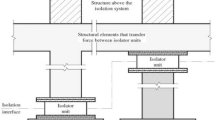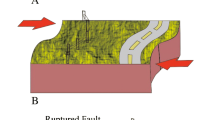Abstract
Self-centering shear wall systems (SCSWSs) exhibit superior seismic capacities with low-damage and self-centering features. However, the cumulative effect under long duration earthquakes would diminish robustness of the system and lead to increased unrecoverable damage. Thus, it should be considered in seismic designs for SCSWSs. This paper applies an energy-based design procedure (EBDP) to SCSWSs in accordance with the Chinese code. A step-by-step design procedure is presented to conduct multi-level designs for SCSWSs using EBDP, while detailed explanations are elaborated corresponding to SCSWS features. A design example is presented to verify the applicability of the EBDP in SCSWSs. The performance of the designed SCSWS is then assessed and compared with a SCSWS designed by the direct displacement-based design method. Results show that the EBDP designed structure has 13% enhanced strength capacity with better controllability in the damage development. The damage index equaling to 0.35 and 0.46 are quantified with two groups of earthquakes, which consists with the performance demands. In addition, deformations are in good agreement with the design objectives, implying reasonable application of the EBDP in SCSWSs.















Similar content being viewed by others
References
ACI Innovation Task Group 5 (2008) Acceptance criteria for special unbonded post-tensioned precast structural walls based on validation testing and commentary. American Concrete Institute, Farmington Hill
ACI Innovation Task Group 5 (2009) Requirements for design of a special unbonded post-tensioned precast shear wall satisfying ACI ITG-5.1 (ACI ITG-5.2-09) and commentary. American Concrete Institute, Farmington Hill
Akiyama H (1985) Earthquake resistant limit state design for building. University of Tokyo Press, Tokyo
Benavent-Climent A (2011) An energy-based method for seismic retrofit of existing frames using hysteretic dampers. Soil Dyn Earthq Eng 31(10):1385–1396
Chou CC, Uang CM (2003) A procedure for evaluating seismic energy demand of framed structures. Earthq Eng Struct Dyn 32(2):229–244
Code for Seismic Design of Buildings [GB 50011-2010 (2016 Edition)]. Ministry of Housing and Urban-rural Construction of the People’s Republic of China
Decanini LD, Mollaioli F (1998) Formulation of elastic earthquake input energy spectra. Earthq Eng Struct Dyn 27(12):1503–1522
Dizaj EA, Madandoust R, Kashani MM (2018) Probabilistic seismic vulnerability analysis of corroded reinforced concrete frames including spatial variability of pitting corrosion. Soil Dyn Earthq Eng 114:97–112
Erkmen B, Schultz AE (2009) Self-centering behavior of unbonded, post-tensioned precast concrete shear walls. J Earthq Eng 13(7):1047–1064
Fajfar P, Gaspersic P (1996) The N2 method for the seismic damage analyses of RC buildings. Earthq Eng Struct Dyn 25(1):31–46
FEMA P695 (2009) Quantification of building seismic performance factors. Federal Emergency Management Agency, Washington, DC
Gullu A, Yuksel E, Yalcin C, Dindar A, Ozkaynak H, Buyukozturk O (2019) An improved input energy spectrum verified by the shake table tests. Earthq Eng Struct Dyn 48(1):27–45
Henry RS (2011) Self-centering precast concrete walls for buildings in regions with low to high seismicity. University of Auckland, Auckland
Housner GW (1959) Limit design of structures to resist earthquakes. In: Proceedings of the first world conference on earthquake engineering
Hudson D (1956) Response spectrum techniques in engineering seismology. In: Proceedings of the world conference on earthquake engineering. Berkeley
Jafari A, Akbarzadeh Bengar H, Hassanli R, Nazari M, Dugnani R (2021a) The response of self-centering concrete walls under quasi-static loading. Bull Earthq Eng 19:2893–2917
Jafari A, Preti M, Beheshti M, Dugnani R (2021b) Self-centering walls strengthening by high-performance concrete: a feasibility study. Mater Struct 54:117
Kurama YC (2000) Seismic design of unbonded post-tensioned precast concrete walls with supplemental viscous damping. ACI Struct J 97(4):648–658
Kurama YC, Sause R, Pessiki S, Lu L (1999) Lateral load behavior and seismic design of unbonded post-tensioned precast concrete walls. ACI Struct J 96(4):622–633
Lu XL, Dang XL, Qian J, Zhou Y, Jiang HJ (2017) Experimental study of self-centering shear walls with horizontal bottom slits. J Struct Eng 143(3):04016183
Mezgebo MG (2015) Estimation of earthquake input energy, hysteretic energy and its distribution in MDOF structures. Syracuse University, Syracuse
Nakashima M, Saburi K, Tsuji B (1996) Energy input and dissipation behavior of structures with hysteretic dampers. Earthq Eng Struct Dyn 25(5):483–496
NZS3101: 2006 (2006a) Concrete Structures Standard: Part I—the design of concrete structures. Standards New Zealand, Wellington
NZS3101: 2006 (2006b) Appendix B: special provisions for the seismic design of ductile jointed precast concrete structural systems. Standards New Zealand, Wellington
Pampanin S, Marriott D, Palermo A (2010) PRESSS design handbook. New Zealand Concrete Society Industry, Auckland
Park YJ, Ang HS (1985) Mechanistic seismic damage model for reinforced concrete. J Struct Eng 111(4):722–739
PEER (2000) Open system of earthquake engineering simulation (OpenSees). University of California, Berkeley
Perez FJ, Sause R, Pessiki S (2007) Analytical and experimental lateral load behavior of unbonded posttensioned precast concrete walls. J Struct Eng 133(11):1531–1540
Priestley MJN (2001) Direct displacement-based design of precast/prestressed concrete buildings. PCI J 74(6):67–79
Rahman AM, Restrepo JI (2000) Earthquake resistant precast concrete buildings: seismic performance of cantilever walls prestressed using unbonded tendons. Research Report 2000-5, University of Canterbury, New Zealand
Restrepo JI, Rahman A (2007) Seismic performance of self-centering structural walls incorporating energy dissipaters. J Struct Eng 133(11):1560–1570
Sadeghi M, Jandaghi Alaee F, Akbarzadeh Bengar A, Jafari A (2022a) Evaluating the efficiency of supplementary rebar system in improving hysteretic damping of self-centering rocking walls. Bull Earthq Eng 20:6075–6107
Sadeghi M, Jandaghi Alaee F, Akbarzadeh Bengar A, Jafari A (2022b) Hysteresis behavior of hybrid rocking walls: an analytical method. Pract Period Struct Des Constr 28(1):04022064
Shen J, Akbas B (1999) Seismic energy demand in steel moment frames. J Earthq Eng 3(4):519–559
Shen SD, Cui Y, Pan P, Ren JY (2019) Development of prefabricated composite energy-dissipating slotted shear wall. Eng Struct 199:109577
Song G, Yang TY, Zhou Y (2021a) Performance evaluation of self-centering rocking shear walls: part 1—quantification of structural damage. Structures 34:2515–2529
Song G, Yang TY, Zhou Y (2021b) Performance evaluation of self-centering rocking shear walls: part 2—determination of performance objectives. Structures 34:3404–3413
Song G, Yang TY, Zhou Y (2021c) Energy-based seismic design for self-centering concrete frames. Bull Earthq Eng 19:5113–5137
Song G, Zhou Y, Yang TY (2022) Review of the energy-based design theory: towards the application to self-centering systems. Resilient Cities Struct 1(1):80–97
Uang CM, Bertero VV (1990) Evaluation of seismic energy in structures. Earthq Eng Struct Dyn 19(2):77–90
Wu H, Zhou Y, Liu WG (2019) Collapse fragility analysis of self-centering precast concrete walls with different post-tensioning and energy dissipation designs. Bull Earthq Eng 17:3593–3613
Yang TY, Tung D, Li YJ (2018) Equivalent energy-based design procedure for earthquake resilient fused structures. Earthq Spectra 34(2):1–21
Yang TY, Atkinson J, Tobber L, Tung DP, Neville B (2020) Seismic design of outrigger systems using equivalent energy design procedure. Struct Des Tall Spec Build 29(10):e1743
Zhou Y, Song G (2020) Design energy spectra for self-centering SDOF systems. Earthq Eng Eng Dyn 40(2):1–12 (in Chinese)
Zhou Y, Song G, Huang SM, Wu H (2019a) Input energy spectra for self-centering SDOF systems. Soil Dyn Earthq Eng 121:293–305
Zhou Y, Song G, Tan P (2019b) Hysteretic energy demand for self-centering SDOF systems. Soil Dyn Earthq Eng 125:105703
Funding
The authors are grateful for the financial support received from Suzhou University of Science and Technology (Grant No. 332211107).
Author information
Authors and Affiliations
Contributions
Manuscript definition of intellectual content: GS. Study concepts: GS. Study design: GS. Data analyses: GS. Manuscript revision/review: LX. Manuscript final version approval: GS, LX.
Corresponding author
Ethics declarations
Conflict of interest
The author declares that they have no known competing financial interests or personal relationships that could have appeared to influence the work reported in this paper.
Additional information
Publisher's Note
Springer Nature remains neutral with regard to jurisdictional claims in published maps and institutional affiliations.
Rights and permissions
Springer Nature or its licensor (e.g. a society or other partner) holds exclusive rights to this article under a publishing agreement with the author(s) or other rightsholder(s); author self-archiving of the accepted manuscript version of this article is solely governed by the terms of such publishing agreement and applicable law.
About this article
Cite this article
Song, G., Xing, L. Application of an energy-based design procedure in self-centering shear wall systems. Bull Earthquake Eng 21, 5743–5766 (2023). https://doi.org/10.1007/s10518-023-01757-0
Received:
Accepted:
Published:
Issue Date:
DOI: https://doi.org/10.1007/s10518-023-01757-0




